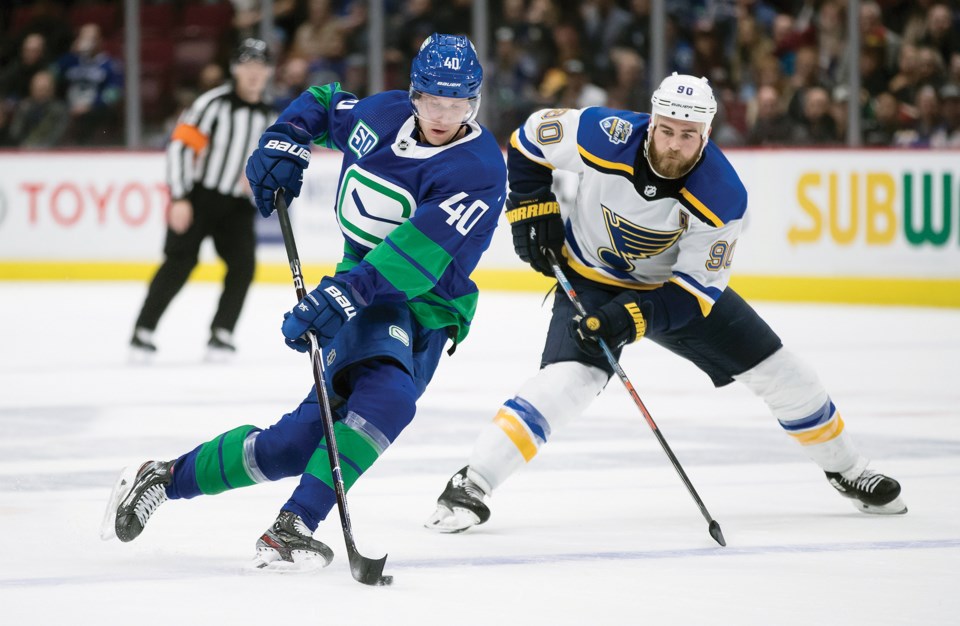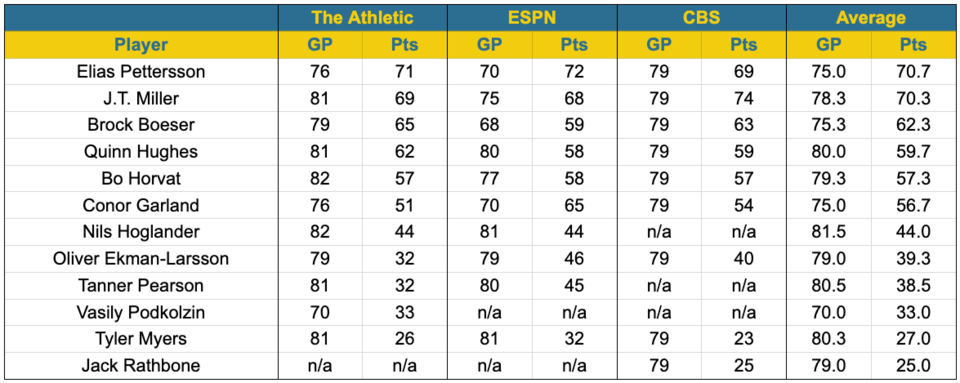The Vancouver Canucks were one of the top-scoring teams in the NHL during the 2019-20 season, finishing eighth in the league with 3.25 goals per game. Last season, their offence ground to a halt.
In a tough year where they lost their franchise centre, Elias Pettersson, for over half the season and dealt with numerous other obstacles, the Canucks managed just 2.64 goals per game, finishing 24th in the NHL.
That needs to change next season. Despite the overhaul on defence and Thatcher Demko in net, the Canucks are unlikely to be a stifling defensive team. They’re going to need to score goals — a lot of them — to get back to the playoffs.
Fortunately, the Canucks have a good-looking group of forwards heading into next season. Also, they’re good at hockey.
Canucks have options galore with top-nine forwards
The additions of Conor Garland, Jason Dickinson, and Vasily Podkolzin should make for a much stronger top-nine if everyone can stay healthy. It’s a group that gives head coach Travis Green plenty of options. He can keep the Lotto Line of J.T. Miller, Elias Pettersson, and Brock Boeser together, give Bo Horvat two talented wingers in Garland and Nils Höglander, and create a checking line of Tanner Pearson, Dickinson, and Podkolzin.
Alternatively, Green could spread out the talent, moving Miller to center and Dickinson to the wing to create three scoring lines, trusting defensive assignments to the fourth line of Tyler Motte, Brandon Sutter, and Matthew Highmore.
It’s an intriguing blend of players but just how much can Canucks fans expect them to score?
To set those expectations, I turned to the realms of fantasy. Fantasy hockey, that is. Regrettably, the works of J.R.R. Tolkien, Terry Pratchett, and Robin Hobb had precious little to say about how many points Elias Pettersson will score next season.
Fantasy hockey projections, on the other hand, do have predictions for how many points Pettersson and the rest of the Canucks will score. Dom Luszczyszyn at The Athletic published his fantasy hockey projections on Wednesday and ESPN and CBS also have point projections among their fantasy hockey tools.
I looked at the projections for 12 Canucks skaters — eight forwards and four defencemen — from these three sources and put them together in this handy-dandy chart, complete with an average of all three projections.
A couple of quick notes before diving in: CBS did their point projections to two decimal places — that’s how you know it’s good stats — but I’ve rounded those projections to the nearest whole number. Also, they inexplicably projected that every single player will appear in 78.7 games.
I’ve included prospects Vasily Podkolzin and Jack Rathbone here, even though only two sources had point projections for either player. CBS is clearly bullish on Rathbone and his 3 points in 8 games last season. He might have a tough time even sticking in the lineup with competition from Olli Juolevi and Brad Hunt, but he’s arguably good enough to be an everyday NHLer, so I don’t mind the projection.
Underselling Pettersson and Boeser
All three fantasy projections are in the same ballpark when it comes to the Canucks’ top forward, projecting 69-72 points food Pettersson, though ESPN has him scoring those 72 points in just 70 games.
Those are conservative projections, likely influenced by his underwhelming 21 points in 26 games last season before he suffered a wrist injury. Pettersson clearly has the capability to put up more points — he was better than a point per game during the 2020 playoffs and he was also a point per game player over his last 20 games of the 2020-21 season after a slow start.
Even a projection of 72 points seems too low. Considering he was on pace for 80 points in the COVID-shortened 2019-20 season and can be expected to take another step forward as he turns 23 next season, Pettersson should be able to out-perform these projections. A more optimistic projection would build off that 80-point pace in 2019-20 and suggest 85-90 points in the 2021-22 season.
In fact, a 72-point projection seems more appropriate for Brock Boeser, who was on pace for 72 points over 82 games last season as he led the Canucks in scoring. That was without Pettersson as his centre for most of the year. If the two of them can stay healthy together next season, they could feed off each other and each hit career years.
The Athletic and CBS both project a small step back for Boeser, however, while ESPN projects a 71-point pace but only 68 games played.
Projectable differences: Oliver Ekman-Larsson
Many of the projections are similar across the three lists. 57-58 points seems reasonable for Bo Horvat and both The Athletic and ESPN project an identical 44 points for Höglander. What’s interesting is where there are big differences.
Oliver Ekman-Larsson is a good example. The Canucks’ trade acquisition has consistently scored around 40 points per season for the Arizona Coyotes, including a 43-point pace across 82 games last season. Based on that, the projections of 46 and 40 points from ESPN and CBS seem pretty reasonable.
The Athletic, however, projects 32 points for Ekman-Larsson, which would match his lowest-ever point total across a full season. It’s understandable why, as Luszczyszyn’s projections also take into account where a player fits on a team’s depth chart.
With Ekman-Larsson unlikely to take Quinn Hughes’s spot on the first power play unit, he may not be able to match his power play point totals from previous seasons. That’s an issue, as it’s traditionally been a prime source for a lot of his scoring.
Accordingly, The Athletic projects just 9 power play points, while ESPN projects 16 power play points. That alone makes up the bulk of the difference between their projections. In addition, Ekman-Larsson may have to carry a heavier defensive load next season, which may drag down his even-strength point totals.
On the other hand, Ekman-Larsson had just a 3.6% shooting percentage last season, well below his career average of 7.4%. He’s typically been a lock to score goals in the double digits every season and had just three goals last season — he could be due for some positive regression there.
Different projectables: Conor Garland
Another player with a wide range of projections is another former member of the Arizona Coyotes: Conor Garland.
It’s understandable why there would be different projections for Garland, as it’s tough to predict exactly how a player will perform for a new team. Luszczyszyn projects 51 points for Garland and CBS is similar at 54 points, but ESPN projects 65 points in just 70 games.
That’s 0.93 points per game, which would be a significant jump up for Garland, who averaged 0.80 points per game last season.
A lot will depend on where Garland slots into the lineup. Garland could be a nice fit alongside Bo Horvat on the second line, but he could also potentially get minutes with Pettersson on the first line. There’s also the question of whether Garland can bump anyone off the top power play unit or if he’ll play on the second unit.
65 points doesn’t seem outrageous as a projection for Garland, but it’s leaning towards the optimistic side, particularly if he only plays 70 games.
What’s interesting is that ESPN also has a higher projection for Tanner Pearson — 45 points to The Athletic’s 32 points. Considering Garland will be taking Pearson’s spot in the top-six and likely on the power play as well, Pearson could have a tough time reaching 45 points, which represents his career-high.
Projecting Podkolzin
The toughest players to project, of course, are those who have yet to play in the NHL. Vasily Podkolzin has put up modest point totals in Russia, but he’s already been pencilled into the Canucks’ opening night lineup.
The Russian rookie has a tenacious defensive game that should immediately endear him to the Canucks’ coaching staff, so the projection of 70 games for Podkolzin seems reasonable. That well-rounded aspect to his game should keep him in the lineup, but offensive production is another question entirely.
The Athletic projects 33 points — 14 goals and 19 assists. In terms of Canucks rookies, that’s a step down from Boeser’s 55 points, Pettersson’s 66 points, Hughes’s 53 points, or even Höglander’s 27 points in 56 games from last season.
Still, 33 points would be solid second-line production and is in line with how a similar player performed at the same age; Valeri Nichushkin had 29 points in 79 games as a 20-year-old after playing in the KHL the previous two seasons.
Podkolzin’s production will depend on where he lands in the lineup. If he finds a fit on a checking third line, points might be harder to come by but he could still have a significant impact. If he gets a chance to play with Horvat on the second line, however, they’ll expect more point production out of him.
Looking at a few of these players with different projections, however, gives rise to an intriguing possibility: between Ekman-Larsson, Garland, Pearson, and Podkolzin, the Canucks have the makings of a very good second power play unit.
Will that be enough for those players to match or exceed their projections? That remains to be seen.





